About Gwalior
Where History Sings and Heritage Lives
Crowned by the timeless hills of Madhya Pradesh, Gwalior is a city where stone whispers tales of valour, music floats in the air, and history walks alongside modernity. Known fondly as the “City of Music,” Gwalior has gifted the world with legendary voices and rhythms, including Tansen, whose melodies still echo through the corridors of Indian classical music. Its fortified hilltops, majestic palaces, and soul-stirring ghats make Gwalior not just a city but an eternal symphony of culture and heritage.

Ancient Roots and the Birth of Gwalior
The story of Gwalior begins with a legend woven in faith and valor. Around the 8th century CE, a local chieftain named Suraj Sen, stricken with leprosy, was miraculously cured by the blessings of the revered hermit Saint Gwalipa. In gratitude, Suraj Sen built a fortress on the hill and named the settlement Gwalior, immortalizing the saint’s name. Through the centuries, Gwalior became a coveted jewel for many dynasties. The Pratiharas were among its early rulers, laying the foundation of its military significance. The Tomar dynasty—most notably under Raja Man Singh Tomar (1486–1516)—transformed Gwalior into a cultural powerhouse, gifting India with the Man Mandir Palace, a wonder of intricate art and architecture. During their reign, the Sas Bahu Temples and the grand Gwalior Fort rose in splendor, turning the hill into a living citadel of history.
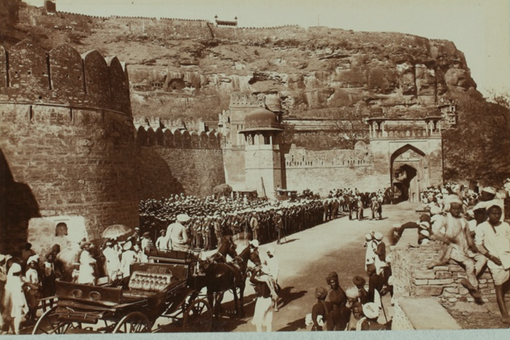
Medieval Glory to the Freedom Struggle
Gwalior’s strategic hilltop fort made it a prized possession for successive empires. The Mughals captured it in the 16th century, and the fort became a vital stronghold in northern India. Later, the Marathas and the Scindias etched their legacy here, leaving behind palaces, gardens, and administrative landmarks that reflected power and refinement. In 1857, the First War of Independence painted Gwalior in the colors of sacrifice. Rani Lakshmibai of Jhansi, a symbol of Indian courage, fought her final and fateful battle near Phool Bagh, where her martyrdom immortalized Gwalior in the annals of freedom. Under the Scindia dynasty, the city flourished as a center of governance, architecture, and culture, bridging royal heritage with colonial transitions.
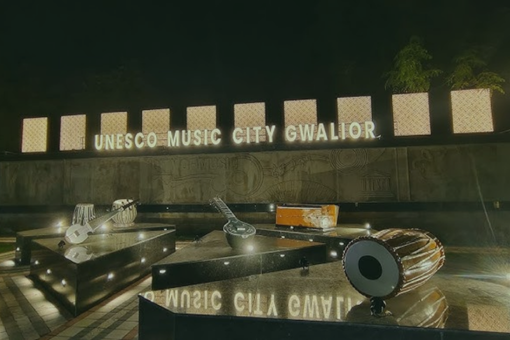
The Cradle of Indian Classical Music
Gwalior’s soul is woven with melody. Known as the birthplace of the Gwalior Gharana, one of the oldest schools of Hindustani classical music, it nurtured legendary maestros, including Miyan Tansen, one of the famed Navaratnas in Emperor Akbar’s court. Even today, the Tansen Sangeet Samaroh draws musicians and enthusiasts from across the globe, transforming the city into a living concert hall of heritage. Its cultural treasures—Jai Vilas Palace, Teli Ka Mandir, Sun Temple, and Gujari Mahal—stand as silent storytellers, while festivals and heritage recognition efforts keep the city on the global cultural map.
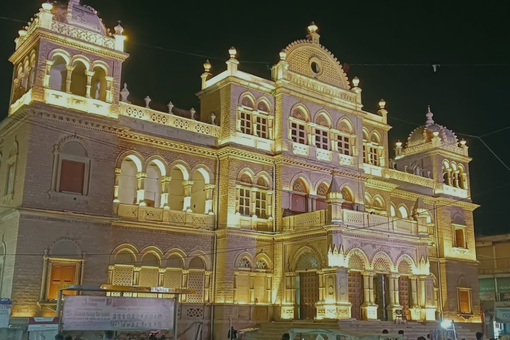
Gwalior Today—A City of Promise and Progress
Modern Gwalior gracefully balances its royal past with contemporary growth. It is a thriving center for tourism, education, and industry, attracting scholars and travelers alike. Prestigious institutions such as Jiwaji University, IIITM, and The Scindia School carry forward its educational legacy, while textile, handicraft, and emerging industries fuel its economy. Well-connected by air, rail, and road, Gwalior is evolving into a cultural and economic hub of central India, offering heritage with opportunity and tradition with innovation.
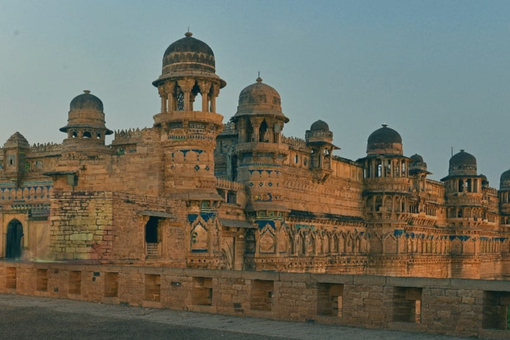
A City Where the Past Meets the Future
Gwalior is more than a destination; it is an experience. Its forts and palaces sing of ancient glory, its music evokes timeless emotion, and its streets invite you to walk through living history. To visit Gwalior is to travel through centuries in a single heartbeat—a city where the echoes of its past inspire the promise of its tomorrow.
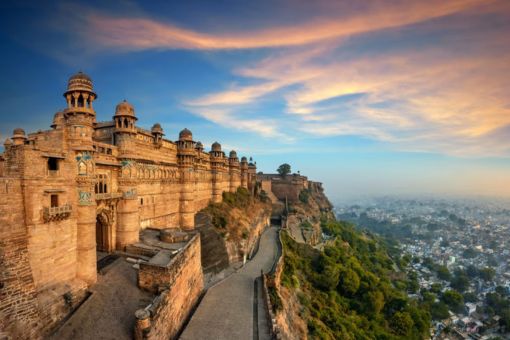
Gwalior Fort Complex
Perched over a sandstone plateau rising about 11 m (covering ~3 km²), Gwalior Fort crowns the city’s skyline with 6 km of winding ramparts, circular bastions, and monumental gates like Hathi Pol and Badalgarh. Originally founded by Suraj Sen around the 8th century CE, it evolved under the Pratiharas, Tomars, Mughals, Marathas, and Scindias. Emperor Babur famously called it “the pearl among the fortresses of Hind.” Within its walls, architectural layers—turquoise‑tile façades, scalloped arches, and intricate jaali patterns—reveal a fusion of Rajput and Mughal sensibilities. Its design exemplifies intercultural exchange and military ingenuity, making it the crown jewel of Central India’s fortress heritage.

Man Mandir Palace
Commissioned by Raja Man Singh Tomar (1486–1517 CE), the Painted Palace—also called Chitra Mandir—commands attention with its vibrant façade tiled in patterns of ducks, parrots, elephants, and mythical creatures. The palace has four levels (two above, two underground), with upper halls featuring carved elephant- and peacock‑brackets, latticed balconies for royal observation, and secret chambers once used during Mughal sieges. This palace remains one of the finest expressions of 15th‑century Rajput art and architecture.
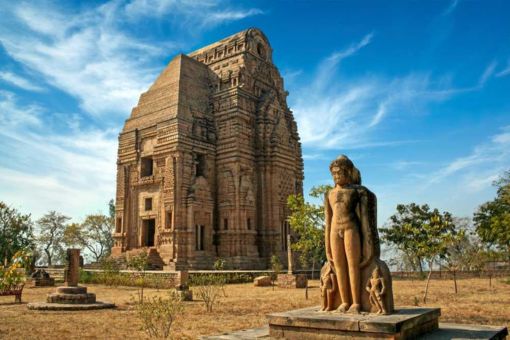
Teli Ka Mandir
Towering nearly 30 m within the fort, Teli Ka Mandir (built ~8th–9th century CE under Pratihara king Mihira Bhoja) is a fusion of Nagara and Valabhi (Dravidian‑style) architecture, rare in North India. Its rectangular sanctum without a mandapa rises under a barrel‑vaulted shikhara, and the walls are adorned with river goddesses, Garuda figures, serpents, and amorous couples. This architectural synthesis, praised for its rhythmic stonework, makes it a masterpiece of early medieval temple design, later restored in the 19th century after centuries of conflict.

Sas‑Bahu Temples
Constructed around 1093 CE by King Mahipala of the Kacchapaghata dynasty, the twin Sas‑Bahu Temples are a showcase of Nagara Bhumija architecture. Though popularly called “mother‑in‑law” and “daughter‑in‑law,” they were originally Sahasra‑Bahu temples dedicated to Vishnu and Shiva. Their mandapas and tiered shikharas, richly carved with celestial dancers, floral scrolls, and divine panels, narrate age‑old myths in stone. Even in partial ruin, the red‑sandstone twins remain an ornament of Gwalior’s sacred heritage.
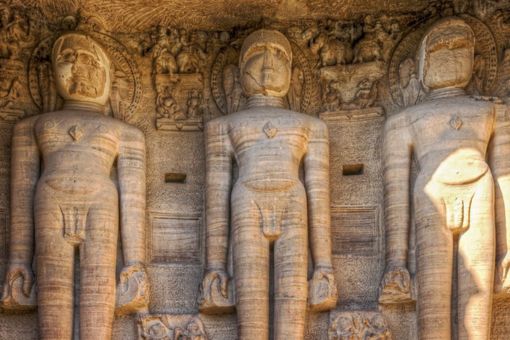
Siddhachal & Gopachal Jain Caves
Carved into Gwalior’s sandstone cliffs between the 7th and 15th centuries CE, the Jain cave clusters are serene sanctuaries of faith. Siddhachal Caves feature 24 towering Tirthankaras, including a 57‑ft standing Rishabhanatha, while Gopachal Caves host seated idols up to 30 ft with the minimalist grace of Digambara Jain tradition. Though defaced during Babur’s 1527 invasion, their calm expressions, precise symmetry, and monolithic scale still inspire awe. Today, they are ASI‑protected monuments celebrated by both pilgrims and historians.
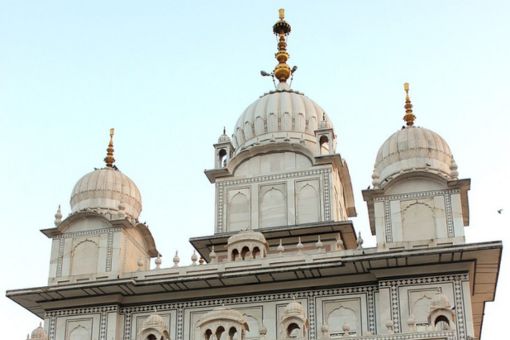
Gurdwara Data Bandi Chhor Sahib
Set within Gwalior Fort’s sacred grounds, this white‑marble Gurudwara commemorates Guru Hargobind Sahib, the sixth Sikh Guru, who was imprisoned here by Emperor Jahangir. The site’s name honors the Bandi Chhor Diwas episode, when the Guru secured the release of 52 captive Rajput princes alongside his own. Its gleaming domes, chhatris, and gilded sanctum create a space of quiet dignity and spiritual freedom, with panoramic views of the fort enhancing its historic significance.
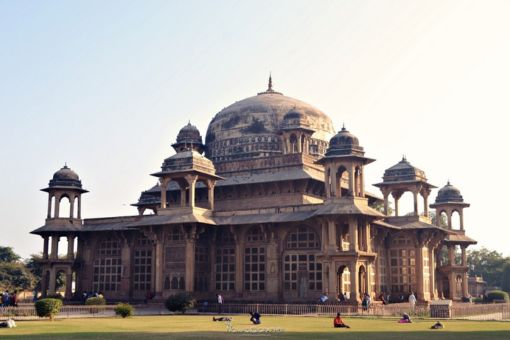
Tomb of Mohammad Ghaus & Tomb of Tansen
Located in Hazira, these 16th‑century Mughal tombs form a confluence of Sufi devotion and Hindustani music heritage.
Tomb of Mohammad Ghaus: A sandstone octagon with delicate jalis and a low bulbous dome, embodying early Mughal garden‑tomb style.
Tomb of Tansen: A modest mausoleum under tamarind shade, resting place of Akbar’s legendary court musician. Each year, the Tansen Sangeet Samaroh transforms the site into a living shrine of Indian classical music.
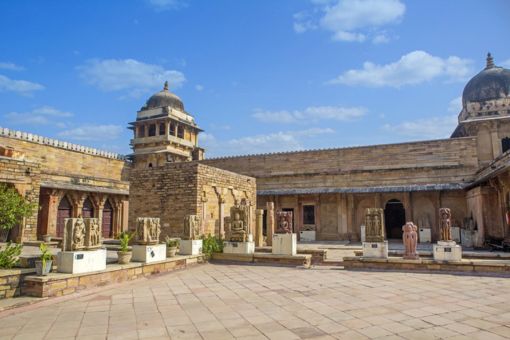
Gujari Mahal Archaeological Museum
Constructed in the 15th century by Raja Man Singh Tomar for his Gujjar queen Mrignayani, Gujari Mahal is a fortified palace with sloped walls and arched galleries. Now an archaeological museum, it houses Gupta‑era sculptures, Shunga terracottas, and rare Jain artifacts spanning 1st century BCE to 17th century CE. The palace itself tells a story of love, cultural pride, and royal patronage.
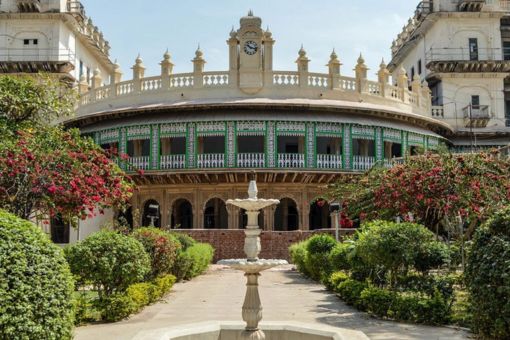
Moti Mahal
This late‑19th‑century Scindia palace in Lashkar served as a hub for administration and ceremonial functions. Its white façade, arched corridors, and Mughal‑inspired jharokhas are adorned with Raga‑Ragini frescoes reflecting Gwalior’s classical music soul. Today, it forms part of the commissioner’s office complex, yet its artistic and historic aura endures.
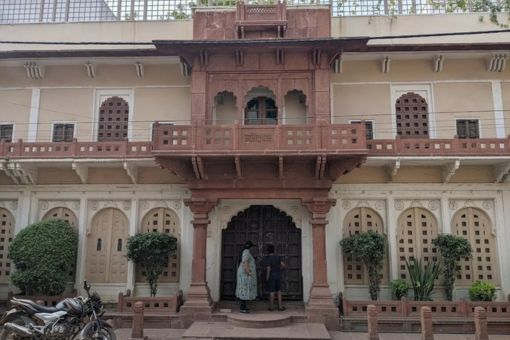
Sarod Ghar (Kala Vithika)
Housed in the ancestral residence of Ustad Hafiz Ali Khan, Sarod Ghar is a unique museum dedicated to Hindustani classical music. Its rare instruments, photographs, and handwritten notes trace the Gwalior Gharana lineage, including Ustad Amjad Ali Khan. Visitors step into intimate rooms and wooden balconies, where archival echoes of ragas transform the museum into a living treasury of sound.
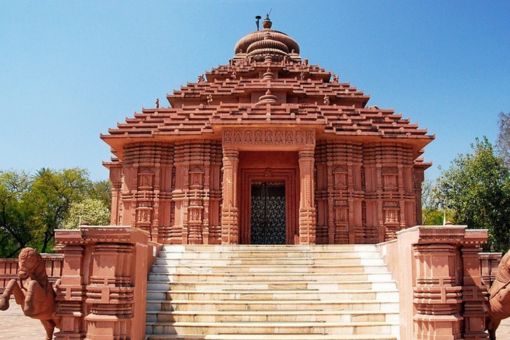
Sun Temple (Surya Mandir)
Built in 1988 by G.D. Birla, the Sun Temple in Morar draws inspiration from Odisha’s Konark Sun Temple. Its red sandstone exterior and white‑marble sanctum form a striking spiritual landmark. With its 24‑wheel chariot base, detailed solar motifs, and landscaped gardens, the temple combines modern craftsmanship with timeless reverence, making it a vital stop on Gwalior’s cultural circuit.

Chhatris of the Scindia Dynasty
Spread across Lashkar and Phool Bagh, the 18th–19th‑century Scindia chhatris are domed cenotaphs honoring the royal lineage. Their Maratha‑Rajasthani architecture, with lotus domes, ornate pillars, and carved balconies, captures a sense of solemn beauty and regal remembrance. These serene monuments are a photogenic and spiritual escape amidst Gwalior’s historic core.
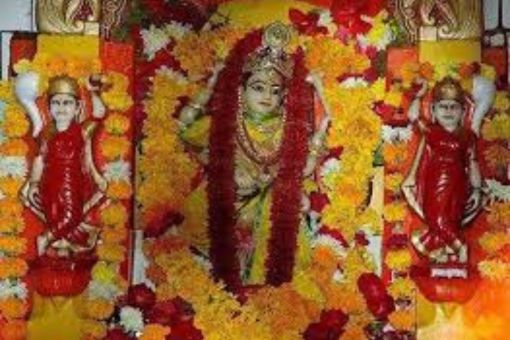
Pitambara Peeth (Datia) — ~70 km
A vibrant Shaktipeeth dedicated to Maa Pitambara (Baglamukhi), this temple complex is a living center of spiritual energy. Its white marble sanctum, ritual yagyashalas, and lakeside setting make it a hub for Tantric practices, cultural gatherings, and deep devotional experiences. Pilgrims flock here to seek protection, blessings, and inner strength, making it one of central India’s most active sacred sites.
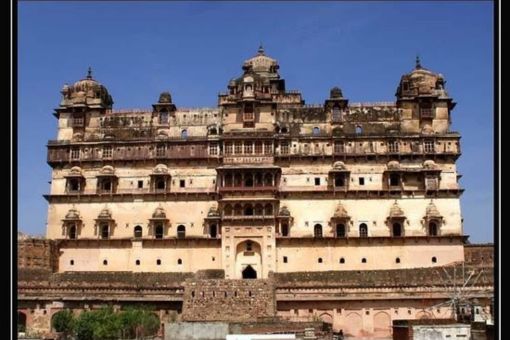
Datia Palace (Bir Singh Palace) — ~75 km
Perched on a rocky hill beside a placid lake, Datia Palace, also called Bir Singh Palace or Satkhanda Mahal, is a masterpiece of Bundela architecture from 1614 CE. Commissioned by Maharaja Bir Singh Deo, this seven‑storey palace was built entirely of stone and brick—without a single beam of wood or iron. Its square plan is crowned with octagonal towers, ribbed domes, and elegant chhatris, while the inner chambers reveal carved lattice balconies and frescoed ceilings inspired by Mughal artistry. Though no king ever permanently resided here, the palace stands as a silent monument to Bundela ambition and architectural ingenuity.
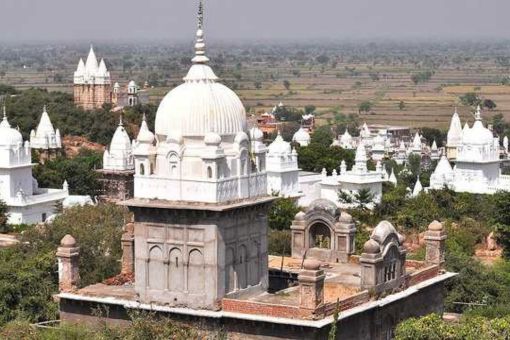
Sonagiri Jain Temples — ~65 km
Rising in brilliant white against the blue sky, the Sonagiri Jain Temples form a sacred pilgrimage believed to be active since the 9th century CE. This sprawling complex of over 100 temples is dedicated to Jain Tirthankaras, with Temple No. 57 housing a majestic 11‑ft idol of Chandraprabha. A 43‑ft manastambha (victory pillar) and a symbolic Samavasarana narrate stories of liberation. Pilgrims believe thousands attained moksha on these serene slopes, where marble spires and silent courtyards evoke both spiritual stillness and medieval architectural elegance.
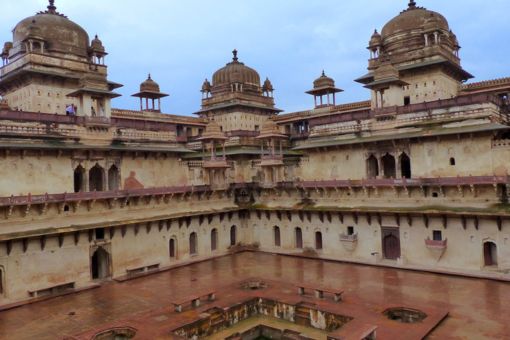
Orchha Fort Complex — ~120 km
Nestled along the Betwa River, Orchha is a living gallery of Bundela grandeur. Founded in 1501 CE by Rudra Pratap Singh, the fort complex contains palaces, temples, and chhatris that capture a rare fusion of Rajput and Mughal design. The highlight, Jahangir Mahal (1610 CE), features turquoise‑tiled façades, elephant‑sized gateways, and 236 chambers that once hosted the Mughal emperor. Across the complex, Raja Mahal, Rani Mahal, and riverbank chhatris form a historic skyline that glows golden at sunset, reflecting centuries of royal hospitality and artistry.
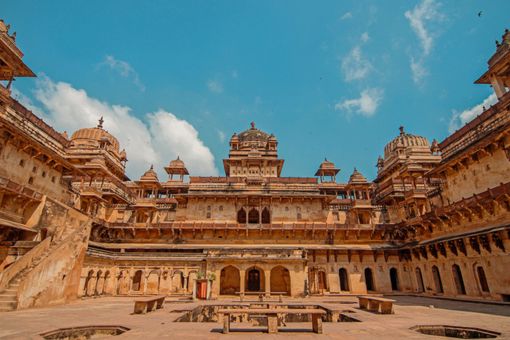
Jahangir Mahal (Orchha) — ~120 km
Built by Vir Singh Deo in 1610 CE to honor Emperor Jahangir’s visit, this palace is the jewel of Orchha’s fort. Designed in a three‑storey square plan, it features hanging balconies, scalloped arches, turquoise tile work, and latticed windows wide enough for royal elephants to pass through the gates below. Inside, the lotus‑themed murals and inlaid floors create an atmosphere where Mughal elegance meets Rajput fortification. Jahangir Mahal remains a timeless symbol of ceremonial splendor and architectural finesse.
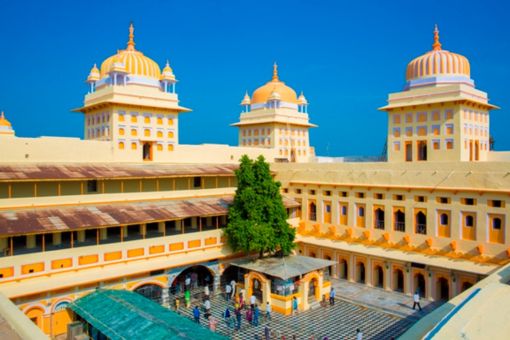
Ram Raja Temple (Orchha) — ~120 km
The Ram Raja Temple is a living palace of devotion, unique in India as the only place where Lord Rama is worshipped as a king. Legend says the idol, brought by Queen Ganeshkuwari from Ayodhya, refused to move from the palace, forcing its conversion into a temple. Daily royal rituals and ceremonial guard salutes uphold the belief that the deity still reigns as Orchha’s sovereign, blending faith, folklore, and regal tradition into an unforgettable spiritual experience.
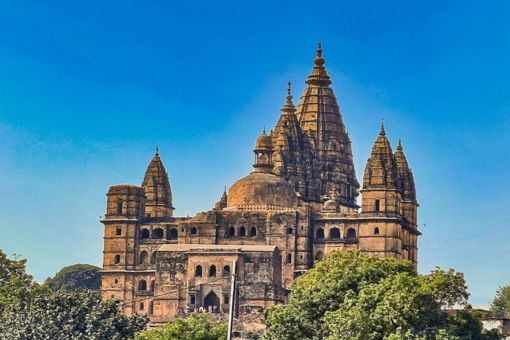
Chaturbhuj Temple (Orchha) — ~120 km
Towering over the town, Chaturbhuj Temple (late 16th century) is a marvel of fortified temple architecture, originally built for Lord Rama. Its 344‑ft shikhara, among the tallest in India, blends Rajput, Mughal, and temple design in one grand cruciform plan. Wide terraces, airy corridors, and panoramic views from its balconies transform a place of worship into a spiritual and architectural landmark, where stone and sky meet in harmony.
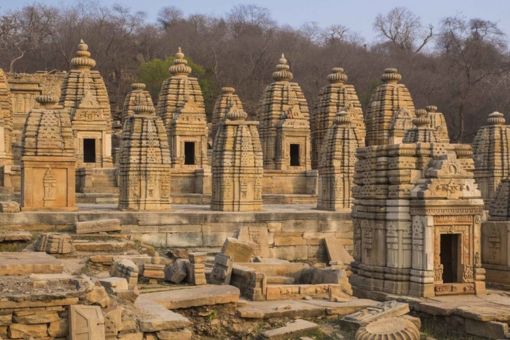
Bateshwar Group of Temples (Padawali) — ~35 km
Spread across gentle sandstone hills, Bateshwar is an 8th–10th century CE temple cluster of nearly 200 shrines dedicated to Shiva and Vishnu. The symmetrical mandapas, friezes of celestial dancers, and miniature shikharas create a mesmerizing stone mosaic across the landscape. Nearby, the Padawali Garhi temple crowns a fortified mound, its 16‑pillar hall and mythological carvings revealing medieval devotion and artistic mastery—a hidden gem of central Indian temple architecture.
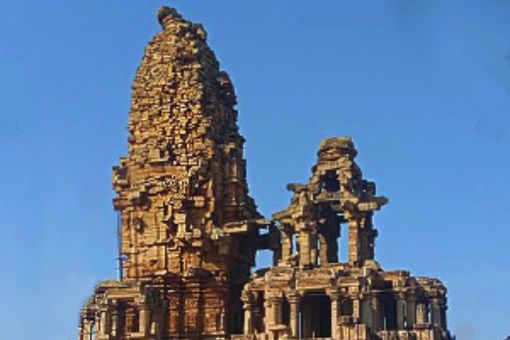
Kakanmath Temple (Sihoniya) — ~60 km
Rising from the plains like a solitary sentinel, Kakanmath Temple (10th–11th century CE) is a Pratihara‑era Shiva shrine celebrated for its soaring shikhara and intricate stone craftsmanship. Though partially ruined, the pillared mandapa, carved niches, and sculpted deities still echo the artistry of its builders. Its mystical isolation and weathered grandeur make it a site where history and legend coexist in quiet majesty.
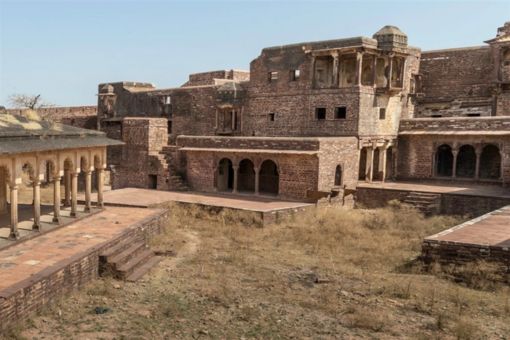
Narwar Fort (Shivpuri district) — ~115 km
Sprawled across 8 km² on a 500‑ft hill, Narwar Fort is a 10th‑century stronghold that changed hands from Kachwaha and Pratihara rulers to Tomars, Mughals, and Marathas. Its multi‑tiered courtyards, Chhip Mahal with repurposed temple pillars, and secret passageways reflect centuries of strategic innovation. Local legend connects it to King Nala and Damayanti, giving a poetic soul to its stone ramparts and weathered bastions.
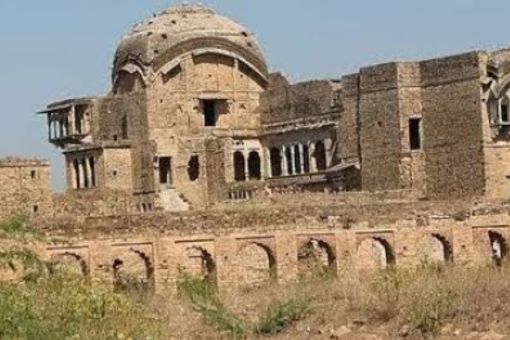
Sabalgarh Fort (Morena district) — ~45 km
Built in the 16th–17th centuries, Sabalgarh Fort sits atop a 100‑ft cliff encircled by robust walls, 12 bastions, and five gateways. Inside, the Nawal Singh Haveli, with its carved jharokhas and domed chhatris, overlooks a serene reservoir. Once held by Sikandar Lodi, Marathas, and the British, the fort is a fusion of history, nature, and folklore, where echoes of past battles meet the tranquility of rural landscapes.
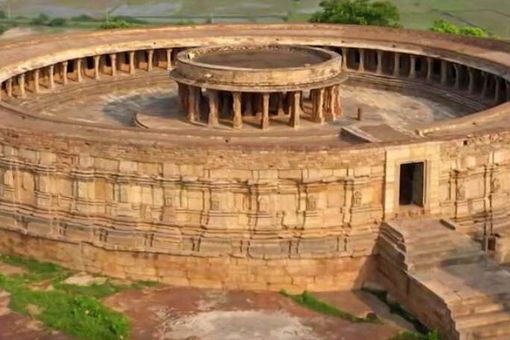
Chausath Yogini Temple (Mitawali) — ~35 km from Gwalior
Perched atop a circular hill in Mitawali, this 10th–11th century CE shrine dedicated to 64 Yoginis is a rare architectural wonder of India. Built under the Kachchhapaghata dynasty, the temple consists of a perfectly circular cloister of 64 chambers surrounding the central shrine of Lord Shiva. Its 360‑degree design, with open pillared mandapas and small niches for each Yogini idol, is often said to have inspired the design of the Indian Parliament building. The stone steps leading up the hill open to breathtaking views of the Chambal ravines, while the quiet sanctum emanates an aura of tantric mysticism and medieval architectural brilliance. Today, it remains a protected monument under ASI, attracting historians, spiritual seekers, and architecture enthusiasts alike.
About Gwalior
Where History Sings and Heritage Lives
Crowned by the timeless hills of Madhya Pradesh, Gwalior is a city where stone whispers tales of valour, music floats in the air, and history walks alongside modernity. Known fondly as the “City of Music,” Gwalior has gifted the world with legendary voices and rhythms, including Tansen, whose melodies still echo through the corridors of Indian classical music. Its fortified hilltops, majestic palaces, and soul-stirring ghats make Gwalior not just a city but an eternal symphony of culture and heritage.
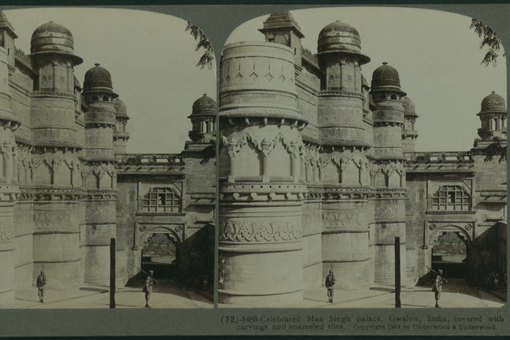
Ancient Roots and the Birth of Gwalior
The story of Gwalior begins with a legend woven in faith and valor. Around the 8th century CE, a local chieftain named Suraj Sen, stricken with leprosy, was miraculously cured by the blessings of the revered hermit Saint Gwalipa. In gratitude, Suraj Sen built a fortress on the hill and named the settlement Gwalior, immortalizing the saint’s name. Through the centuries, Gwalior became a coveted jewel for many dynasties. The Pratiharas were among its early rulers, laying the foundation of its military significance. The Tomar dynasty—most notably under Raja Man Singh Tomar (1486–1516)—transformed Gwalior into a cultural powerhouse, gifting India with the Man Mandir Palace, a wonder of intricate art and architecture. During their reign, the Sas Bahu Temples and the grand Gwalior Fort rose in splendor, turning the hill into a living citadel of history.

Medieval Glory to the Freedom Struggle
Gwalior’s strategic hilltop fort made it a prized possession for successive empires. The Mughals captured it in the 16th century, and the fort became a vital stronghold in northern India. Later, the Marathas and the Scindias etched their legacy here, leaving behind palaces, gardens, and administrative landmarks that reflected power and refinement. In 1857, the First War of Independence painted Gwalior in the colors of sacrifice. Rani Lakshmibai of Jhansi, a symbol of Indian courage, fought her final and fateful battle near Phool Bagh, where her martyrdom immortalized Gwalior in the annals of freedom. Under the Scindia dynasty, the city flourished as a center of governance, architecture, and culture, bridging royal heritage with colonial transitions.

The Cradle of Indian Classical Music
Gwalior’s soul is woven with melody. Known as the birthplace of the Gwalior Gharana, one of the oldest schools of Hindustani classical music, it nurtured legendary maestros, including Miyan Tansen, one of the famed Navaratnas in Emperor Akbar’s court. Even today, the Tansen Sangeet Samaroh draws musicians and enthusiasts from across the globe, transforming the city into a living concert hall of heritage. Its cultural treasures—Jai Vilas Palace, Teli Ka Mandir, Sun Temple, and Gujari Mahal—stand as silent storytellers, while festivals and heritage recognition efforts keep the city on the global cultural map.
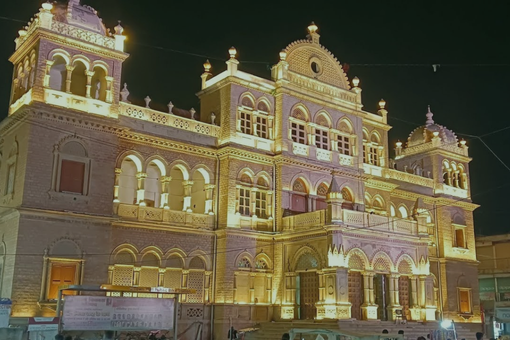
Gwalior Today—A City of Promise and Progress
Modern Gwalior gracefully balances its royal past with contemporary growth. It is a thriving center for tourism, education, and industry, attracting scholars and travelers alike. Prestigious institutions such as Jiwaji University, IIITM, and The Scindia School carry forward its educational legacy, while textile, handicraft, and emerging industries fuel its economy. Well-connected by air, rail, and road, Gwalior is evolving into a cultural and economic hub of central India, offering heritage with opportunity and tradition with innovation.
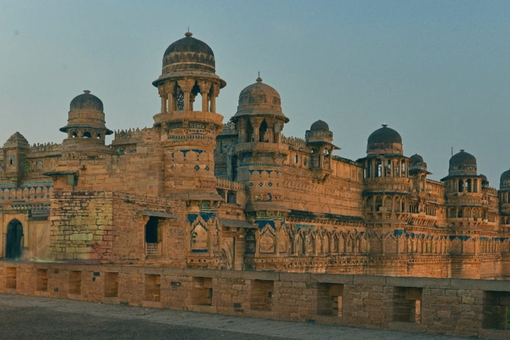
A City Where the Past Meets the Future
Gwalior is more than a destination; it is an experience. Its forts and palaces sing of ancient glory, its music evokes timeless emotion, and its streets invite you to walk through living history. To visit Gwalior is to travel through centuries in a single heartbeat—a city where the echoes of its past inspire the promise of its tomorrow.
Gwalior City Heritage
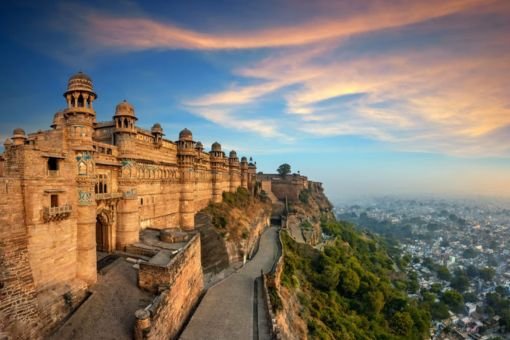
Gwalior Fort Complex
Perched over a sandstone plateau rising about 11 m (covering ~3 km²), Gwalior Fort crowns the city’s skyline with 6 km of winding ramparts, circular bastions, and monumental gates like Hathi Pol and Badalgarh. Originally founded by Suraj Sen around the 8th century CE, it evolved under the Pratiharas, Tomars, Mughals, Marathas, and Scindias. Emperor Babur famously called it “the pearl among the fortresses of Hind.” Within its walls, architectural layers—turquoise‑tile façades, scalloped arches, and intricate jaali patterns—reveal a fusion of Rajput and Mughal sensibilities. Its design exemplifies intercultural exchange and military ingenuity, making it the crown jewel of Central India’s fortress heritage.

Man Mandir Palace
Commissioned by Raja Man Singh Tomar (1486–1517 CE), the Painted Palace—also called Chitra Mandir—commands attention with its vibrant façade tiled in patterns of ducks, parrots, elephants, and mythical creatures. The palace has four levels (two above, two underground), with upper halls featuring carved elephant- and peacock‑brackets, latticed balconies for royal observation, and secret chambers once used during Mughal sieges. This palace remains one of the finest expressions of 15th‑century Rajput art and architecture.

Teli Ka Mandir
Towering nearly 30 m within the fort, Teli Ka Mandir (built ~8th–9th century CE under Pratihara king Mihira Bhoja) is a fusion of Nagara and Valabhi (Dravidian‑style) architecture, rare in North India. Its rectangular sanctum without a mandapa rises under a barrel‑vaulted shikhara, and the walls are adorned with river goddesses, Garuda figures, serpents, and amorous couples. This architectural synthesis, praised for its rhythmic stonework, makes it a masterpiece of early medieval temple design, later restored in the 19th century after centuries of conflict.

Sas‑Bahu Temples
Constructed around 1093 CE by King Mahipala of the Kacchapaghata dynasty, the twin Sas‑Bahu Temples are a showcase of Nagara Bhumija architecture. Though popularly called “mother‑in‑law” and “daughter‑in‑law,” they were originally Sahasra‑Bahu temples dedicated to Vishnu and Shiva. Their mandapas and tiered shikharas, richly carved with celestial dancers, floral scrolls, and divine panels, narrate age‑old myths in stone. Even in partial ruin, the red‑sandstone twins remain an ornament of Gwalior’s sacred heritage.
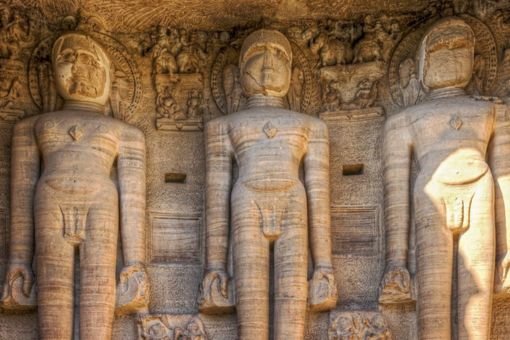
Siddhachal & Gopachal Jain Caves
Carved into Gwalior’s sandstone cliffs between the 7th and 15th centuries CE, the Jain cave clusters are serene sanctuaries of faith. Siddhachal Caves feature 24 towering Tirthankaras, including a 57‑ft standing Rishabhanatha, while Gopachal Caves host seated idols up to 30 ft with the minimalist grace of Digambara Jain tradition. Though defaced during Babur’s 1527 invasion, their calm expressions, precise symmetry, and monolithic scale still inspire awe. Today, they are ASI‑protected monuments celebrated by both pilgrims and historians.
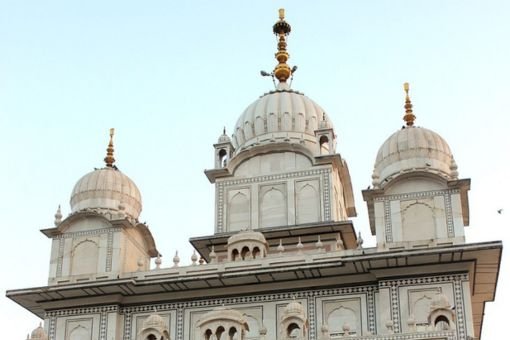
Gurdwara Data Bandi Chhor Sahib
Set within Gwalior Fort’s sacred grounds, this white‑marble Gurudwara commemorates Guru Hargobind Sahib, the sixth Sikh Guru, who was imprisoned here by Emperor Jahangir. The site’s name honors the Bandi Chhor Diwas episode, when the Guru secured the release of 52 captive Rajput princes alongside his own. Its gleaming domes, chhatris, and gilded sanctum create a space of quiet dignity and spiritual freedom, with panoramic views of the fort enhancing its historic significance.
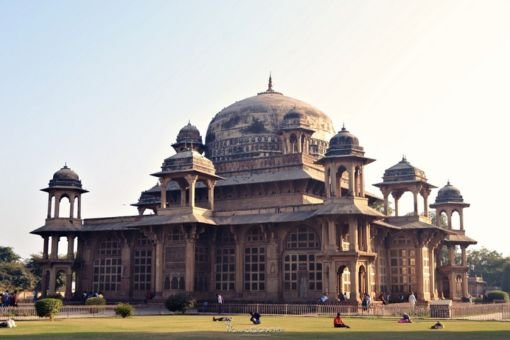
Tomb of Mohammad Ghaus & Tomb of Tansen
Located in Hazira, these 16th‑century Mughal tombs form a confluence of Sufi devotion and Hindustani music heritage.
Tomb of Mohammad Ghaus: A sandstone octagon with delicate jalis and a low bulbous dome, embodying early Mughal garden‑tomb style.
Tomb of Tansen: A modest mausoleum under tamarind shade, resting place of Akbar’s legendary court musician. Each year, the Tansen Sangeet Samaroh transforms the site into a living shrine of Indian classical music.
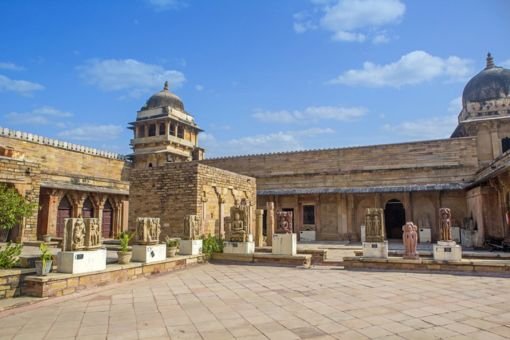
Gujari Mahal Archaeological Museum
Constructed in the 15th century by Raja Man Singh Tomar for his Gujjar queen Mrignayani, Gujari Mahal is a fortified palace with sloped walls and arched galleries. Now an archaeological museum, it houses Gupta‑era sculptures, Shunga terracottas, and rare Jain artifacts spanning 1st century BCE to 17th century CE. The palace itself tells a story of love, cultural pride, and royal patronage.
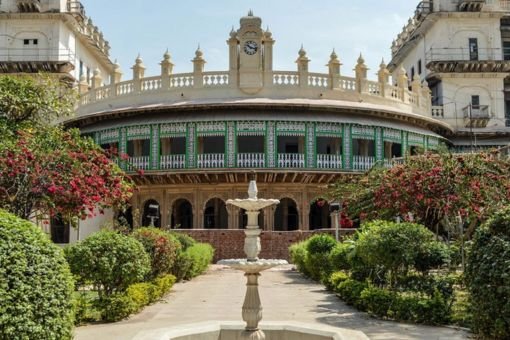
Moti Mahal
This late‑19th‑century Scindia palace in Lashkar served as a hub for administration and ceremonial functions. Its white façade, arched corridors, and Mughal‑inspired jharokhas are adorned with Raga‑Ragini frescoes reflecting Gwalior’s classical music soul. Today, it forms part of the commissioner’s office complex, yet its artistic and historic aura endures.

Sarod Ghar (Kala Vithika)
Housed in the ancestral residence of Ustad Hafiz Ali Khan, Sarod Ghar is a unique museum dedicated to Hindustani classical music. Its rare instruments, photographs, and handwritten notes trace the Gwalior Gharana lineage, including Ustad Amjad Ali Khan. Visitors step into intimate rooms and wooden balconies, where archival echoes of ragas transform the museum into a living treasury of sound.

Sun Temple (Surya Mandir)
Built in 1988 by G.D. Birla, the Sun Temple in Morar draws inspiration from Odisha’s Konark Sun Temple. Its red sandstone exterior and white‑marble sanctum form a striking spiritual landmark. With its 24‑wheel chariot base, detailed solar motifs, and landscaped gardens, the temple combines modern craftsmanship with timeless reverence, making it a vital stop on Gwalior’s cultural circuit.

Chhatris of the Scindia Dynasty
Spread across Lashkar and Phool Bagh, the 18th–19th‑century Scindia chhatris are domed cenotaphs honoring the royal lineage. Their Maratha‑Rajasthani architecture, with lotus domes, ornate pillars, and carved balconies, captures a sense of solemn beauty and regal remembrance. These serene monuments are a photogenic and spiritual escape amidst Gwalior’s historic core.
Within 100 Kms
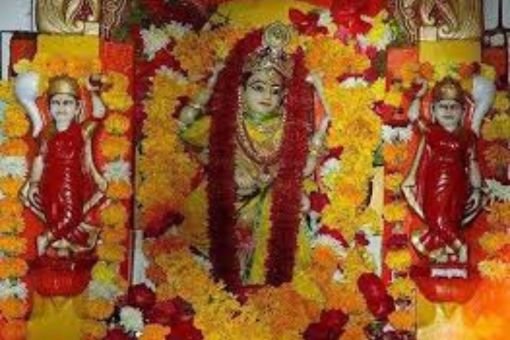
Pitambara Peeth (Datia) — ~70 km
A vibrant Shaktipeeth dedicated to Maa Pitambara (Baglamukhi), this temple complex is a living center of spiritual energy. Its white marble sanctum, ritual yagyashalas, and lakeside setting make it a hub for Tantric practices, cultural gatherings, and deep devotional experiences. Pilgrims flock here to seek protection, blessings, and inner strength, making it one of central India’s most active sacred sites.
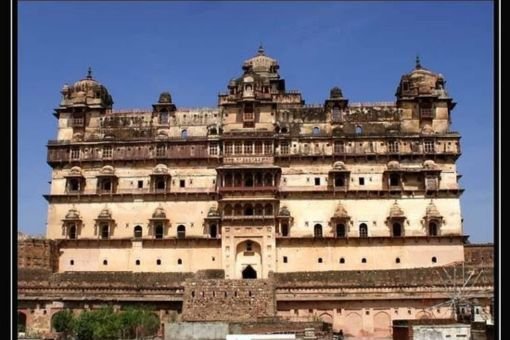
Datia Palace (Bir Singh Palace) — ~75 km
Perched on a rocky hill beside a placid lake, Datia Palace, also called Bir Singh Palace or Satkhanda Mahal, is a masterpiece of Bundela architecture from 1614 CE. Commissioned by Maharaja Bir Singh Deo, this seven‑storey palace was built entirely of stone and brick—without a single beam of wood or iron. Its square plan is crowned with octagonal towers, ribbed domes, and elegant chhatris, while the inner chambers reveal carved lattice balconies and frescoed ceilings inspired by Mughal artistry. Though no king ever permanently resided here, the palace stands as a silent monument to Bundela ambition and architectural ingenuity.

Sonagiri Jain Temples — ~65 km
Rising in brilliant white against the blue sky, the Sonagiri Jain Temples form a sacred pilgrimage believed to be active since the 9th century CE. This sprawling complex of over 100 temples is dedicated to Jain Tirthankaras, with Temple No. 57 housing a majestic 11‑ft idol of Chandraprabha. A 43‑ft manastambha (victory pillar) and a symbolic Samavasarana narrate stories of liberation. Pilgrims believe thousands attained moksha on these serene slopes, where marble spires and silent courtyards evoke both spiritual stillness and medieval architectural elegance.
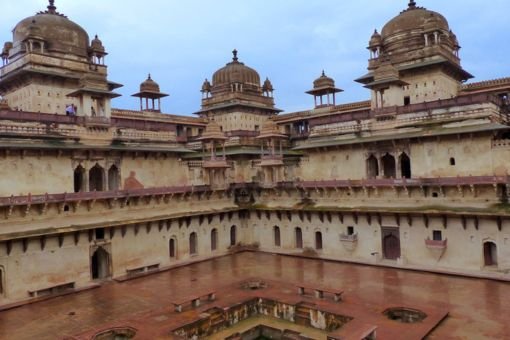
Orchha Fort Complex — ~120 km
Nestled along the Betwa River, Orchha is a living gallery of Bundela grandeur. Founded in 1501 CE by Rudra Pratap Singh, the fort complex contains palaces, temples, and chhatris that capture a rare fusion of Rajput and Mughal design. The highlight, Jahangir Mahal (1610 CE), features turquoise‑tiled façades, elephant‑sized gateways, and 236 chambers that once hosted the Mughal emperor. Across the complex, Raja Mahal, Rani Mahal, and riverbank chhatris form a historic skyline that glows golden at sunset, reflecting centuries of royal hospitality and artistry.
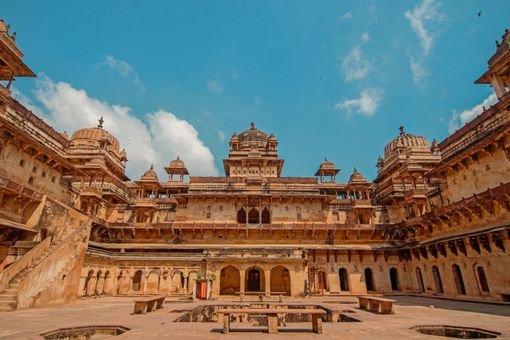
Jahangir Mahal (Orchha) — ~120 km
Built by Vir Singh Deo in 1610 CE to honor Emperor Jahangir’s visit, this palace is the jewel of Orchha’s fort. Designed in a three‑storey square plan, it features hanging balconies, scalloped arches, turquoise tile work, and latticed windows wide enough for royal elephants to pass through the gates below. Inside, the lotus‑themed murals and inlaid floors create an atmosphere where Mughal elegance meets Rajput fortification. Jahangir Mahal remains a timeless symbol of ceremonial splendor and architectural finesse.

Ram Raja Temple (Orchha) — ~120 km
The Ram Raja Temple is a living palace of devotion, unique in India as the only place where Lord Rama is worshipped as a king. Legend says the idol, brought by Queen Ganeshkuwari from Ayodhya, refused to move from the palace, forcing its conversion into a temple. Daily royal rituals and ceremonial guard salutes uphold the belief that the deity still reigns as Orchha’s sovereign, blending faith, folklore, and regal tradition into an unforgettable spiritual experience.

Chaturbhuj Temple (Orchha) — ~120 km
Towering over the town, Chaturbhuj Temple (late 16th century) is a marvel of fortified temple architecture, originally built for Lord Rama. Its 344‑ft shikhara, among the tallest in India, blends Rajput, Mughal, and temple design in one grand cruciform plan. Wide terraces, airy corridors, and panoramic views from its balconies transform a place of worship into a spiritual and architectural landmark, where stone and sky meet in harmony.

Bateshwar Group of Temples (Padawali) — ~35 km
Spread across gentle sandstone hills, Bateshwar is an 8th–10th century CE temple cluster of nearly 200 shrines dedicated to Shiva and Vishnu. The symmetrical mandapas, friezes of celestial dancers, and miniature shikharas create a mesmerizing stone mosaic across the landscape. Nearby, the Padawali Garhi temple crowns a fortified mound, its 16‑pillar hall and mythological carvings revealing medieval devotion and artistic mastery—a hidden gem of central Indian temple architecture.

Kakanmath Temple (Sihoniya) — ~60 km
Rising from the plains like a solitary sentinel, Kakanmath Temple (10th–11th century CE) is a Pratihara‑era Shiva shrine celebrated for its soaring shikhara and intricate stone craftsmanship. Though partially ruined, the pillared mandapa, carved niches, and sculpted deities still echo the artistry of its builders. Its mystical isolation and weathered grandeur make it a site where history and legend coexist in quiet majesty.
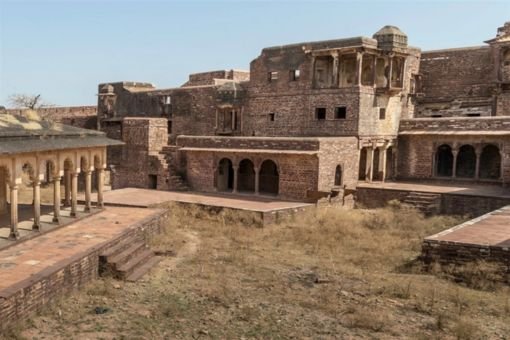
Narwar Fort (Shivpuri district) — ~115 km
Sprawled across 8 km² on a 500‑ft hill, Narwar Fort is a 10th‑century stronghold that changed hands from Kachwaha and Pratihara rulers to Tomars, Mughals, and Marathas. Its multi‑tiered courtyards, Chhip Mahal with repurposed temple pillars, and secret passageways reflect centuries of strategic innovation. Local legend connects it to King Nala and Damayanti, giving a poetic soul to its stone ramparts and weathered bastions.
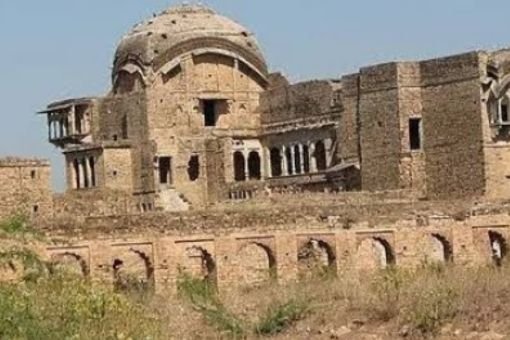
Sabalgarh Fort (Morena district) — ~45 km
Built in the 16th–17th centuries, Sabalgarh Fort sits atop a 100‑ft cliff encircled by robust walls, 12 bastions, and five gateways. Inside, the Nawal Singh Haveli, with its carved jharokhas and domed chhatris, overlooks a serene reservoir. Once held by Sikandar Lodi, Marathas, and the British, the fort is a fusion of history, nature, and folklore, where echoes of past battles meet the tranquility of rural landscapes.

Chausath Yogini Temple (Mitawali) — ~35 km from Gwalior
Perched atop a circular hill in Mitawali, this 10th–11th century CE shrine dedicated to 64 Yoginis is a rare architectural wonder of India. Built under the Kachchhapaghata dynasty, the temple consists of a perfectly circular cloister of 64 chambers surrounding the central shrine of Lord Shiva. Its 360‑degree design, with open pillared mandapas and small niches for each Yogini idol, is often said to have inspired the design of the Indian Parliament building. The stone steps leading up the hill open to breathtaking views of the Chambal ravines, while the quiet sanctum emanates an aura of tantric mysticism and medieval architectural brilliance. Today, it remains a protected monument under ASI, attracting historians, spiritual seekers, and architecture enthusiasts alike.

Gwalior Fort Complex
Perched over a sandstone plateau rising about 11 m (covering ~3 km²), Gwalior Fort crowns the city’s skyline with 6 km of winding ramparts, circular bastions, and monumental gates like Hathi Pol and Badalgarh. Originally founded by Suraj Sen around the 8th century CE, it evolved under the Pratiharas, Tomars, Mughals, Marathas, and Scindias. Emperor Babur famously called it “the pearl among the fortresses of Hind.” Within its walls, architectural layers—turquoise‑tile façades, scalloped arches, and intricate jaali patterns—reveal a fusion of Rajput and Mughal sensibilities. Its design exemplifies intercultural exchange and military ingenuity, making it the crown jewel of Central India’s fortress heritage.

Man Mandir Palace
Commissioned by Raja Man Singh Tomar (1486–1517 CE), the Painted Palace—also called Chitra Mandir—commands attention with its vibrant façade tiled in patterns of ducks, parrots, elephants, and mythical creatures. The palace has four levels (two above, two underground), with upper halls featuring carved elephant- and peacock‑brackets, latticed balconies for royal observation, and secret chambers once used during Mughal sieges. This palace remains one of the finest expressions of 15th‑century Rajput art and architecture.

Teli Ka Mandir
Towering nearly 30 m within the fort, Teli Ka Mandir (built ~8th–9th century CE under Pratihara king Mihira Bhoja) is a fusion of Nagara and Valabhi (Dravidian‑style) architecture, rare in North India. Its rectangular sanctum without a mandapa rises under a barrel‑vaulted shikhara, and the walls are adorned with river goddesses, Garuda figures, serpents, and amorous couples. This architectural synthesis, praised for its rhythmic stonework, makes it a masterpiece of early medieval temple design, later restored in the 19th century after centuries of conflict.

Sas‑Bahu Temples
Constructed around 1093 CE by King Mahipala of the Kacchapaghata dynasty, the twin Sas‑Bahu Temples are a showcase of Nagara Bhumija architecture. Though popularly called “mother‑in‑law” and “daughter‑in‑law,” they were originally Sahasra‑Bahu temples dedicated to Vishnu and Shiva. Their mandapas and tiered shikharas, richly carved with celestial dancers, floral scrolls, and divine panels, narrate age‑old myths in stone. Even in partial ruin, the red‑sandstone twins remain an ornament of Gwalior’s sacred heritage.

Siddhachal & Gopachal Jain Caves
Carved into Gwalior’s sandstone cliffs between the 7th and 15th centuries CE, the Jain cave clusters are serene sanctuaries of faith. Siddhachal Caves feature 24 towering Tirthankaras, including a 57‑ft standing Rishabhanatha, while Gopachal Caves host seated idols up to 30 ft with the minimalist grace of Digambara Jain tradition. Though defaced during Babur’s 1527 invasion, their calm expressions, precise symmetry, and monolithic scale still inspire awe. Today, they are ASI‑protected monuments celebrated by both pilgrims and historians.

Gurdwara Data Bandi Chhor Sahib
Set within Gwalior Fort’s sacred grounds, this white‑marble Gurudwara commemorates Guru Hargobind Sahib, the sixth Sikh Guru, who was imprisoned here by Emperor Jahangir. The site’s name honors the Bandi Chhor Diwas episode, when the Guru secured the release of 52 captive Rajput princes alongside his own. Its gleaming domes, chhatris, and gilded sanctum create a space of quiet dignity and spiritual freedom, with panoramic views of the fort enhancing its historic significance.

Tomb of Mohammad Ghaus & Tomb of Tansen
Located in Hazira, these 16th‑century Mughal tombs form a confluence of Sufi devotion and Hindustani music heritage.
Tomb of Mohammad Ghaus: A sandstone octagon with delicate jalis and a low bulbous dome, embodying early Mughal garden‑tomb style.
Tomb of Tansen: A modest mausoleum under tamarind shade, resting place of Akbar’s legendary court musician. Each year, the Tansen Sangeet Samaroh transforms the site into a living shrine of Indian classical music.

Gujari Mahal Archaeological Museum
Constructed in the 15th century by Raja Man Singh Tomar for his Gujjar queen Mrignayani, Gujari Mahal is a fortified palace with sloped walls and arched galleries. Now an archaeological museum, it houses Gupta‑era sculptures, Shunga terracottas, and rare Jain artifacts spanning 1st century BCE to 17th century CE. The palace itself tells a story of love, cultural pride, and royal patronage.

Moti Mahal
This late‑19th‑century Scindia palace in Lashkar served as a hub for administration and ceremonial functions. Its white façade, arched corridors, and Mughal‑inspired jharokhas are adorned with Raga‑Ragini frescoes reflecting Gwalior’s classical music soul. Today, it forms part of the commissioner’s office complex, yet its artistic and historic aura endures.

Sarod Ghar (Kala Vithika)
Housed in the ancestral residence of Ustad Hafiz Ali Khan, Sarod Ghar is a unique museum dedicated to Hindustani classical music. Its rare instruments, photographs, and handwritten notes trace the Gwalior Gharana lineage, including Ustad Amjad Ali Khan. Visitors step into intimate rooms and wooden balconies, where archival echoes of ragas transform the museum into a living treasury of sound.

Sun Temple (Surya Mandir)
Built in 1988 by G.D. Birla, the Sun Temple in Morar draws inspiration from Odisha’s Konark Sun Temple. Its red sandstone exterior and white‑marble sanctum form a striking spiritual landmark. With its 24‑wheel chariot base, detailed solar motifs, and landscaped gardens, the temple combines modern craftsmanship with timeless reverence, making it a vital stop on Gwalior’s cultural circuit.

Chhatris of the Scindia Dynasty
Spread across Lashkar and Phool Bagh, the 18th–19th‑century Scindia chhatris are domed cenotaphs honoring the royal lineage. Their Maratha‑Rajasthani architecture, with lotus domes, ornate pillars, and carved balconies, captures a sense of solemn beauty and regal remembrance. These serene monuments are a photogenic and spiritual escape amidst Gwalior’s historic core.

Pitambara Peeth (Datia) — ~70 km
A vibrant Shaktipeeth dedicated to Maa Pitambara (Baglamukhi), this temple complex is a living center of spiritual energy. Its white marble sanctum, ritual yagyashalas, and lakeside setting make it a hub for Tantric practices, cultural gatherings, and deep devotional experiences. Pilgrims flock here to seek protection, blessings, and inner strength, making it one of central India’s most active sacred sites.

Datia Palace (Bir Singh Palace) — ~75 km
Perched on a rocky hill beside a placid lake, Datia Palace, also called Bir Singh Palace or Satkhanda Mahal, is a masterpiece of Bundela architecture from 1614 CE. Commissioned by Maharaja Bir Singh Deo, this seven‑storey palace was built entirely of stone and brick—without a single beam of wood or iron. Its square plan is crowned with octagonal towers, ribbed domes, and elegant chhatris, while the inner chambers reveal carved lattice balconies and frescoed ceilings inspired by Mughal artistry. Though no king ever permanently resided here, the palace stands as a silent monument to Bundela ambition and architectural ingenuity.

Sonagiri Jain Temples — ~65 km
Rising in brilliant white against the blue sky, the Sonagiri Jain Temples form a sacred pilgrimage believed to be active since the 9th century CE. This sprawling complex of over 100 temples is dedicated to Jain Tirthankaras, with Temple No. 57 housing a majestic 11‑ft idol of Chandraprabha. A 43‑ft manastambha (victory pillar) and a symbolic Samavasarana narrate stories of liberation. Pilgrims believe thousands attained moksha on these serene slopes, where marble spires and silent courtyards evoke both spiritual stillness and medieval architectural elegance.

Orchha Fort Complex — ~120 km
Nestled along the Betwa River, Orchha is a living gallery of Bundela grandeur. Founded in 1501 CE by Rudra Pratap Singh, the fort complex contains palaces, temples, and chhatris that capture a rare fusion of Rajput and Mughal design. The highlight, Jahangir Mahal (1610 CE), features turquoise‑tiled façades, elephant‑sized gateways, and 236 chambers that once hosted the Mughal emperor. Across the complex, Raja Mahal, Rani Mahal, and riverbank chhatris form a historic skyline that glows golden at sunset, reflecting centuries of royal hospitality and artistry.

Jahangir Mahal (Orchha) — ~120 km
Built by Vir Singh Deo in 1610 CE to honor Emperor Jahangir’s visit, this palace is the jewel of Orchha’s fort. Designed in a three‑storey square plan, it features hanging balconies, scalloped arches, turquoise tile work, and latticed windows wide enough for royal elephants to pass through the gates below. Inside, the lotus‑themed murals and inlaid floors create an atmosphere where Mughal elegance meets Rajput fortification. Jahangir Mahal remains a timeless symbol of ceremonial splendor and architectural finesse.

Ram Raja Temple (Orchha) — ~120 km
The Ram Raja Temple is a living palace of devotion, unique in India as the only place where Lord Rama is worshipped as a king. Legend says the idol, brought by Queen Ganeshkuwari from Ayodhya, refused to move from the palace, forcing its conversion into a temple. Daily royal rituals and ceremonial guard salutes uphold the belief that the deity still reigns as Orchha’s sovereign, blending faith, folklore, and regal tradition into an unforgettable spiritual experience.

Chaturbhuj Temple (Orchha) — ~120 km
Towering over the town, Chaturbhuj Temple (late 16th century) is a marvel of fortified temple architecture, originally built for Lord Rama. Its 344‑ft shikhara, among the tallest in India, blends Rajput, Mughal, and temple design in one grand cruciform plan. Wide terraces, airy corridors, and panoramic views from its balconies transform a place of worship into a spiritual and architectural landmark, where stone and sky meet in harmony.

Bateshwar Group of Temples (Padawali) — ~35 km
Spread across gentle sandstone hills, Bateshwar is an 8th–10th century CE temple cluster of nearly 200 shrines dedicated to Shiva and Vishnu. The symmetrical mandapas, friezes of celestial dancers, and miniature shikharas create a mesmerizing stone mosaic across the landscape. Nearby, the Padawali Garhi temple crowns a fortified mound, its 16‑pillar hall and mythological carvings revealing medieval devotion and artistic mastery—a hidden gem of central Indian temple architecture.

Kakanmath Temple (Sihoniya) — ~60 km
Rising from the plains like a solitary sentinel, Kakanmath Temple (10th–11th century CE) is a Pratihara‑era Shiva shrine celebrated for its soaring shikhara and intricate stone craftsmanship. Though partially ruined, the pillared mandapa, carved niches, and sculpted deities still echo the artistry of its builders. Its mystical isolation and weathered grandeur make it a site where history and legend coexist in quiet majesty.

Narwar Fort (Shivpuri district) — ~115 km
Sprawled across 8 km² on a 500‑ft hill, Narwar Fort is a 10th‑century stronghold that changed hands from Kachwaha and Pratihara rulers to Tomars, Mughals, and Marathas. Its multi‑tiered courtyards, Chhip Mahal with repurposed temple pillars, and secret passageways reflect centuries of strategic innovation. Local legend connects it to King Nala and Damayanti, giving a poetic soul to its stone ramparts and weathered bastions.

Sabalgarh Fort (Morena district) — ~45 km
Built in the 16th–17th centuries, Sabalgarh Fort sits atop a 100‑ft cliff encircled by robust walls, 12 bastions, and five gateways. Inside, the Nawal Singh Haveli, with its carved jharokhas and domed chhatris, overlooks a serene reservoir. Once held by Sikandar Lodi, Marathas, and the British, the fort is a fusion of history, nature, and folklore, where echoes of past battles meet the tranquility of rural landscapes.

Chausath Yogini Temple (Mitawali) — ~35 km from Gwalior
Perched atop a circular hill in Mitawali, this 10th–11th century CE shrine dedicated to 64 Yoginis is a rare architectural wonder of India. Built under the Kachchhapaghata dynasty, the temple consists of a perfectly circular cloister of 64 chambers surrounding the central shrine of Lord Shiva. Its 360‑degree design, with open pillared mandapas and small niches for each Yogini idol, is often said to have inspired the design of the Indian Parliament building. The stone steps leading up the hill open to breathtaking views of the Chambal ravines, while the quiet sanctum emanates an aura of tantric mysticism and medieval architectural brilliance. Today, it remains a protected monument under ASI, attracting historians, spiritual seekers, and architecture enthusiasts alike.
